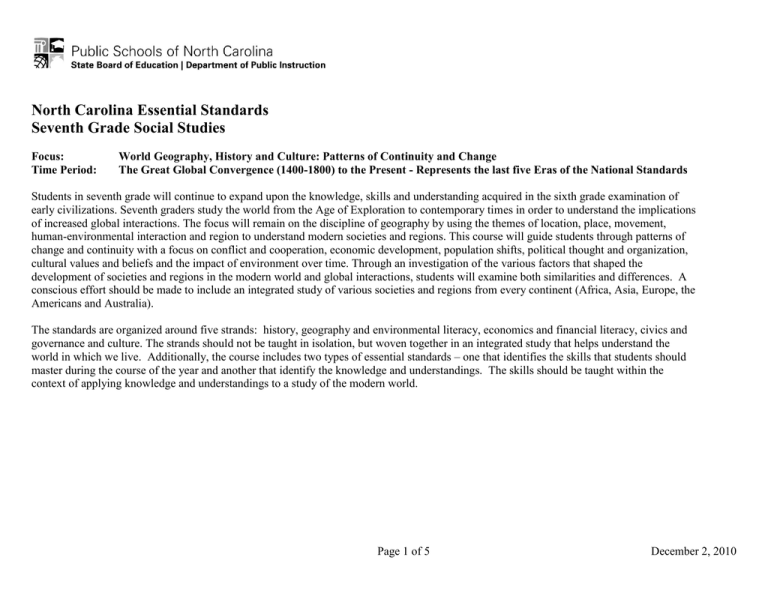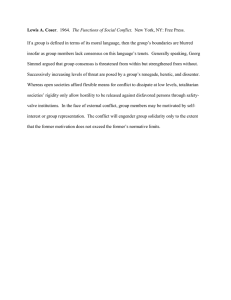North Carolina Essential Standards Seventh Grade Social Studies
advertisement

North Carolina Essential Standards Seventh Grade Social Studies Focus: Time Period: World Geography, History and Culture: Patterns of Continuity and Change The Great Global Convergence (1400-1800) to the Present - Represents the last five Eras of the National Standards Students in seventh grade will continue to expand upon the knowledge, skills and understanding acquired in the sixth grade examination of early civilizations. Seventh graders study the world from the Age of Exploration to contemporary times in order to understand the implications of increased global interactions. The focus will remain on the discipline of geography by using the themes of location, place, movement, human-environmental interaction and region to understand modern societies and regions. This course will guide students through patterns of change and continuity with a focus on conflict and cooperation, economic development, population shifts, political thought and organization, cultural values and beliefs and the impact of environment over time. Through an investigation of the various factors that shaped the development of societies and regions in the modern world and global interactions, students will examine both similarities and differences. A conscious effort should be made to include an integrated study of various societies and regions from every continent (Africa, Asia, Europe, the Americans and Australia). The standards are organized around five strands: history, geography and environmental literacy, economics and financial literacy, civics and governance and culture. The strands should not be taught in isolation, but woven together in an integrated study that helps understand the world in which we live. Additionally, the course includes two types of essential standards – one that identifies the skills that students should master during the course of the year and another that identify the knowledge and understandings. The skills should be taught within the context of applying knowledge and understandings to a study of the modern world. Page 1 of 5 December 2, 2010 North Carolina Essential Standards Seventh Grade Social Studies Note on Strands: H–History, G–Geography and Environmental Literacy, E–Economics and Financial Literacy, CG–Civics and Governance, and C–Culture History 7.H.1 Essential Standard Clarifying Objectives Use historical thinking to analyze various modern societies. 7.H.1.1 7.H.1.2 7.H.1.3 7.H.2 Understand the implications of global interactions. 7.H.2.1 7.H.2.2 7.H.2.3 7.H.2.4 Page 2 of 5 Construct charts, graphs, and historical narratives to explain particular events or issues over time. Summarize the literal meaning of historical documents in order to establish context. Use primary and secondary sources to interpret various historical perspectives. Analyze the effects of social, economic, military and political conflict among nations, regions, and groups (e.g. war, genocide, imperialism and colonization). Evaluate the effectiveness of cooperative efforts and consensus building among nations, regions, and groups (e.g. Humanitarian efforts, United Nations, World Health Organization, Non Governmental Organizations, European Union and Organization of American States). Explain how increased global interaction accelerates the pace of innovation in modern societies (e.g. advancements in transportation, communication networks and business practices). Analyze the economic, political, and social impacts of disease (e.g. smallpox, malaria, bubonic plague, AIDS and avian flu) in modern societies. August 23, 2012 North Carolina Essential Standards Seventh Grade Social Studies Geography and Environmental Literacy 7.G.1 Essential Standard Clarifying Objectives Understand how geography, demographic trends, and environmental conditions shape modern societies and regions. 7.G.1.1 7.G.1.2 7.G.1.3 7.G.2 Apply the tools of a geographer to understand modern societies and regions. 7.G.2.1 7.G.2.2 Page 3 of 5 Explain how environmental conditions and human response to those conditions influence modern societies and regions (e.g. natural barriers, scarcity of resources and factors that influence settlement). Explain how demographic trends (e.g. population growth and decline, push/pull factors and urbanization) lead to conflict, negotiation, and compromise in modern societies and regions. Explain how natural disasters (e.g. flooding, earthquakes, monsoons and tsunamis), preservation efforts and human modification of the environment (e.g. recycling, planting trees, deforestation, pollution, irrigation systems and climate change) affect modern societies and regions. Construct maps, charts, and graphs to explain data about geographic phenomena (e.g. migration patterns and population and resource distribution patterns). Use maps, charts, graphs, geographic data and available technology tools (i.e. GPS and GIS software) to interpret and draw conclusions about social, economic, and environmental issues in modern societies and regions. August 23, 2012 North Carolina Essential Standards Seventh Grade Social Studies Economics and Financial Literacy Essential Standard 7.E.1 Clarifying Objectives Understand the economic activities of modern 7.E.1.1 societies and regions. 7.E.1.2 7.E.1.3 7.E.1.4 Explain how competition for resources affects the economic relationship among nations (e.g. colonialism, imperialism, globalization and interdependence). Explain the implications of economic decisions in national and international affairs (e.g. OPEC, NAFTA, G20, WTO, EU and economic alliances). Summarize the main characteristics of various economic systems (e.g. capitalism, socialism, communism; market, mixed, command and traditional economies). Explain how personal financial decision-making impacts quality of life (e.g. credit, savings, investing, borrowing and giving). Civics and Government 7.C&G.1 Essential Standard Clarifying Objectives Understand the development of government in modern societies and regions. 7.C&G.1.1 7.C&G.1.2 7.C&G.1.3 Page 4 of 5 Summarize the ideas that have shaped political thought in various societies and regions (e.g. Enlightenment and Scientific Revolution, democracy, communism and socialism). Evaluate how the Western concept of democracy has influenced the political ideas of modern societies. Compare the requirements for (e.g. age, gender, legal and economic status) and responsibilities of citizenship under August 23, 2012 North Carolina Essential Standards Seventh Grade Social Studies Essential Standard Clarifying Objectives 7.C&G.1.4 various governments in modern societies (e.g. voting, taxes and military service). Compare the sources of power and governmental authority in various societies (e.g. monarchs, dictators, elected officials, anti-governmental groups and religious, political factions). Culture 7.C.1 Essential Standard Clarifying Objectives Understand how cultural values influence relationships between individuals, groups and political entities in modern societies and regions. 7.C.1.1 7.C.1.2 Page 5 of 5 Explain how culture unites and divides modern societies and regions (e.g. enslavement of various peoples, caste system, religious conflict and Social Darwinism). Explain how cultural expressions (e.g. art, literature, architecture and music) influence modern society. August 23, 2012









